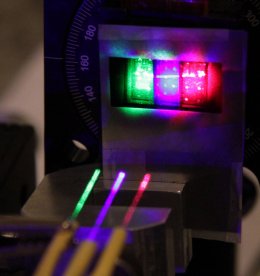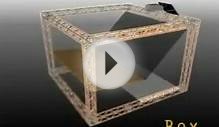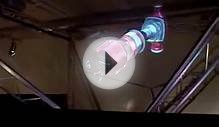
 We obtained high-quality color images experimentally from a very simple optical setup consisting of three fiber-coupled lasers and an SLM (a Holoeye PLUTO). Light emerges from the fine-cut ends of the fibers and illuminates the SLM. Each fiber carries light in a primary color (red light at 671nm, green at 532nm, and blue at 445nm) and illuminates its designated area of a third of the active window3 of the SLM panel (see Figure 1).
We obtained high-quality color images experimentally from a very simple optical setup consisting of three fiber-coupled lasers and an SLM (a Holoeye PLUTO). Light emerges from the fine-cut ends of the fibers and illuminates the SLM. Each fiber carries light in a primary color (red light at 671nm, green at 532nm, and blue at 445nm) and illuminates its designated area of a third of the active window3 of the SLM panel (see Figure 1).
Light is reflected from the surface of the SLM with the appropriate phase shift for the intended pixel. The SLM works like a miniaturized PC monitor, where every pixel can be addressed with a brightness value between 0 and 255, yielding a given phase shift due to specific reorientation of liquid crystal molecules. In this way, any given distribution of phase retardation can be applied to an impinging wavefront by simply displaying prepared bitmap files on the SLM.
The image quality depends solely on those distributions, and the critical part of the process is their optimal calculation. In our approach, the input frame is split into its color components, forming three separate bitmap files. Each of these files is then treated separately with a Gerchberg–Saxton4 iterative phase optimization algorithm. The outcome after 5–10 iterations is an optimized phase distribution of a Fourier hologram of the input frame. Such a hologram can be reconstructed by illuminating with a light beam converging in the plane of the projection screen. Our light fibers give divergent beams, and so the phase distribution of a highly focusing lens must be added to the holographic distributions by a complex multiplication operation. The focal length of the virtual lens is established separately for each color sub-hologram to obtain sharp holographic reconstructed images on the screen. The alignment of the sub-images in the , y directions is achieved electronically by the inclusion of properly oriented phase factors of saw-tooth gratings in the holographic design. For example, multiplying a hologram with the phase factor of a grating with a period of 32μm shifts the image on the projection screen by ∼2cm in a direction dependent on the orientation of the saw-tooth grating. Figure 2 shows examples captured at a projection distance of 1m.
2. M. Makowski, I. Ducin, K. Kakarenko, A. Kolodziejczyk, A. Siemion, A. Siemion, J. Suszek, M. Sypek, D. Wojnowski, Efficient image projection by Fourier electroholography, Opt. Lett. 36(16), p. 3018-3020, 2011. doi:10.1364/OL.36.0030183. T. Shimobaba, T. Takahashi, N. Masuda, T. Ito, Numerical study of color holographic projection using space-division method, Opt. Express 19(11), p. 2, 2011. doi:10.1364/OE.19.010287
Wojnowski, Efficient image projection by Fourier electroholography, Opt. Lett. 36(16), p. 3018-3020, 2011. doi:10.1364/OL.36.0030183. T. Shimobaba, T. Takahashi, N. Masuda, T. Ito, Numerical study of color holographic projection using space-division method, Opt. Express 19(11), p. 2, 2011. doi:10.1364/OE.19.010287
4. R. W. Gerchberg, W. O. Saxton, A practical algorithm for the determination of the phase from image and diffraction plane pictures, Optik 35(2), p. 237-246, 1972.
5. P.-H. Yao, C.-H. Chen, C.-H. Chen, Low speckle laser illuminated projection system with a vibrating diffractive beam shaper, Opt. Express 20(15), p. 6, 2012. doi:10.1364/OE.20.0165526. H. Kim, B. Yang, B. Lee, Iterative Fourier transform algorithm with regularization for the optimal design of diffractive optical elements, J. Opt. Soc. Am. A 21(12), p. 2353-2365, 2004. doi:10.1364/JOSAA.21.002353
wikimapia.org tools.folha.com.br foro.infojardin.com camfrog.com engawa.kakaku.com search.auone.jp telstra.com.au drinksmixer.com rtve curseforge.com kaskus.co.id digitalcollections.clemson.edu superherohype.com researchgate talgov.com minecraft.curseforge.com astro.wisc.edu popcouncil.org nutritiondata.self.comRELATED VIDEO











